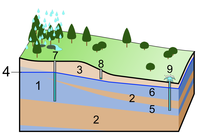
Photo from wikipedia
Hydrological and hydrochemical processes occurring within riparian zones in temperate mid-latitudes flatland areas have significant implications for water management by controlling nutrient transfer between the watershed and the stream system.… Click to show full abstract
Hydrological and hydrochemical processes occurring within riparian zones in temperate mid-latitudes flatland areas have significant implications for water management by controlling nutrient transfer between the watershed and the stream system. The riparian zone in a high-order flatland stream located within a 7063-km2 agricultural watershed in Argentina was investigated to study its hydrological connectivity to upland zones, interactions with the stream, and their implications for groundwater hydrochemistry. The analysis was based on 9-year-long time series of groundwater/stream water levels collected along a 220-m-long transect comprising six piezometers, a river stage sensor, and hydrochemical information from 37 groundwater/stream water sampling campaigns. Samples were analyzed for electrical conductivity (EC), Cl−, SO4+2, (Ca+2 + Mg+2), pH, and redox potential (ORP). Data were interpreted using descriptive statistics, statistical tests, groundwater flux calculations, and identification of hydrological patterns and associated hydrochemical responses. The system was hydrologically controlled by shallow groundwater. Three representative landscape hydrological patterns were identified: disconnected, incipient-weakly connected, and fully connected. Groundwater hydrochemistry was closely linked to hydrological connectivity, which played an important role in the mobilization and fluxes of solutes. Overall, groundwater EC, Cl−, SO4+2, and (Ca+2 + Mg+2) concentrations decreased from upland to lowland. For full connectivity, Cl− concentrations reduced 33%, while SO4+2 reduced 42%, demonstrating the system’s buffering capacity. This investigation constitutes the first attempt to formulate the riparian zone functioning in this agricultural region and has contributed to the understanding on the complex interactions between hydrologic regimes of large flatland-high-order streams and shallow groundwater systems in fine-texture sediments.
Journal Title: Environmental Monitoring and Assessment
Year Published: 2018
Link to full text (if available)
Share on Social Media: Sign Up to like & get
recommendations!